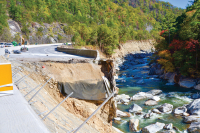Anticipated Trout Capital designation likely to spur fly fishing tourism

If all goes according to plan, by this time next year Jackson County will have been declared the trout capital of North Carolina, and county commissioners are already starting to talk about how to plan for the resulting increase they anticipate in angling tourism.
“When we get that additional publicity about it being the trout capital, I think there will be more people,” said Commissioner Vicki Greene. “I know that’s a good thing.”
Jackson County just about has it all where trout fishing is concerned, with the N.C. Wildlife Resources Commission stocking its 4,600 miles of waterways with 92,000 fish each year — more than any other county in the state. The county is full of breathtaking scenery and beautiful stretches of river, making it an attractive destination for anglers from all over. And each of their visits, in turn, drops hundreds of dollars per day on food, lodging, fly equipment and entertainment.
“That has great economic impact on us in terms of supporting our tourism jobs,” said Nick Breedlove, director of the Jackson County Tourism Development Authority.
According to a 2009 study commissioned by the Wildlife Commission, in 2008 an estimated 93,000 anglers spent about $146 million on mountain trout fishing trips in the 24 western counties, supporting 1,997 jobs and providing $56 million in income.
But with angling visitation anticipated to increase, county commissioners are beginning to plan for how to ensure tourists co-exist harmoniously with the people who already live and play around the waters where they’ll be casting their lines.
Related Items
“It’s just working with all involved to come up with a solution that supports growth, but not at the detriment to the people that live here,” said Breedlove, himself a Jackson County native. “It’s important that we grow toward it sustainably, that it doesn’t negatively impact the people from here.”
The logistics of angling tourism
County commissioners recently held a work session bringing together representatives from the Jackson County Sheriff’s Office, N.C. Department of Transportation and N.C. Wildlife Resources Commission to discuss the issue, with Greene telling the group that she’s already heard some complaints from constituents inconvenienced by people parking where they’re not supposed to, on private property.
“It is something I’ve seen firsthand,” she said. “It is something I’ve had complaints about and having seen it that Saturday for myself, it was a real thing.”
On the day Greene referred to, she’d left her home in the Webster area and saw cars parked all over the bank between Old Settlement Road and the Tuckasegee River, even passing by someone who had managed to set up a tent on the bank. On Saturdays, the road often sees angling-related congestion, Greene said.
“We need to do a better job of telling them where they should be parking,” she said.
But trespassing complaints are not common where anglers are concerned, Tim Lominac of the Wildlife Commission’s enforcement division told commissioners.
“I’ve spent a lot of time on the Tuckasegee River enforcing fishing laws, and I can honestly say in 18 years I’ve never had a property owner complain that someone has accessed their property for fishing purposes,” he said.
“That’s why they call their commissioners,” Greene responded.
Commissioners praised the conduct of professional fly fishing guides in the area, saying they’re generally cognizant of private property rules and keep their clients from trespassing or causing any issues. But people visiting from out of the area for a day on the river might not have a handle on where it’s OK to park and where it’s not.
There are state laws protecting landowners who don’t want people parking on their property or cutting through it to access the river, Lominac said. According to the 2011 Landowner Protection Act, landowners can mark their property with signs or vertical lines of purple paint to prevent trespassing. If people ignore those marks, a wildlife officer can write a citation.
Going forward, the county might look at publishing guidelines for visiting anglers, educating them on trespassing laws and directing them to parking spots and river accesses that are legal for them to use. Depending how things transpire, the county may also begin to consider creating designated parking areas specifically for anglers.
“As we go down the road, we may be looking to identify areas where we can create some public access points where people could have a place where they can park their car and go fish and access the area for other activities,” McMahan said.
The county will also be keeping an eye on things from a traffic standpoint. As river-based recreation develops, some areas could see upticks in traffic volume and pedestrian crossings. Finding ways to keep things safe for river users will be important.
To that end, commissioners have asked the DOT to conduct a traffic study on Old Cullowhee Road near the new greenway access point at Locust Creek. The area is seeing more use now, and people often drive above the posted 45-mile-per-hour speed limit, McMahan said. It would be worthwhile to look for ways to slow things down, reducing the chance of an accident in the future.
There’s nothing going horrifically wrong with angling tourism right now, McMahan stressed. In fact, it’s a sector that the county is glad to see growing and hopes will continue to blossom with the Trout City designation anticipated to come in the next state legislative session.
“We want to, on the front end before we see an increase in volume, make sure we know what the rules and procedures are and see if we can’t do a good job of communicating that with people who may be visiting the river,” McMahan said.
A rising tide
The number of visitors is indeed increasing alongside efforts to market fly fishing in Jackson County. Since the maps were first printed in 2009, the Jackson County Chamber of Commerce has distributed 195,000 water-resistant maps of the WNC Fly Fishing Trail through Jackson County, which show many of the county’s must-hit fishing holes. Distribution has increased year over year, with 2016 distribution up about 5 percent over 2015.
Fly fishing is on the rise nationwide, as well. Between 2002 and 2012, retail spending on fly fishing rose from $686 million to $748.6 million, according to annual reports from the American Fly Fishing Trade Organization, with the Southern U.S.’ share of those sales increasing from 16.3 percent to 23.7 percent during the same time period.
“I expect our fall fishing season to be strong, and the map will once again be in high demand,” said Jackson County Chamber of Commerce Director Julie Spiro.
That’s a reality that shows promise to the region but will also necessitate ongoing dialogue between tourism leaders, Breedlove said.
“It’s definitely something that we want to understand better, and understand how the TDA and the various stakeholders involved can work with the county,” he said, “because we only see the number of visitors increasing related to fly fishing and fishing in general going forward.”









